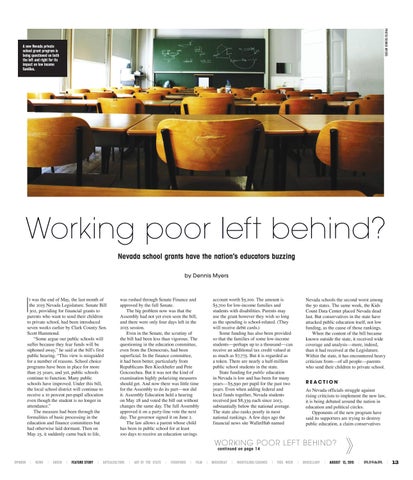PHOTO/DENNIS MYERS
A new Nevada private school grant program is being questioned on both the left and right for its impact on low income families.
Working poor left behind? Nevada school grants have the nation’s educators buzzing by Dennis Myers
I
t was the end of May, the last month of the 2015 Nevada Legislature. Senate Bill 302, providing for financial grants to parents who want to send their children to private school, had been introduced seven weeks earlier by Clark County Sen. Scott Hammond. “Some argue our public schools will suffer because they fear funds will be siphoned away,” he said at the bill’s first public hearing. “This view is misguided for a number of reasons. School choice programs have been in place for more than 25 years, and yet, public schools continue to function. Many public schools have improved. Under this bill, the local school district will continue to receive a 10 percent per-pupil allocation even though the student is no longer in attendance.” The measure had been through the formalities of basic processing in the education and finance committees but had otherwise laid dormant. Then on May 25, it suddenly came back to life,
was rushed through Senate Finance and approved by the full Senate. The big problem now was that the Assembly had not yet even seen the bill, and there were only four days left in the 2015 session. Even in the Senate, the scrutiny of the bill had been less than vigorous. The questioning in the education committee, even from the Democrats, had been superficial. In the finance committee, it had been better, particularly from Republicans Ben Kieckhefer and Pete Goicoechea. But it was not the kind of examination highly polarizing measures should get. And now there was little time for the Assembly to do its part—nor did it. Assembly Education held a hearing on May 28 and voted the bill out without changes the same day. The full Assembly approved it on a party-line vote the next day. The governor signed it on June 2. The law allows a parent whose child has been in public school for at least 100 days to receive an education savings
account worth $5,100. The amount is $5,700 for low-income families and students with disabilities. Parents may use the grant however they wish so long as the spending is school-related. (They will receive debit cards.) Some funding has also been provided so that the families of some low-income students—perhaps up to a thousand—can receive an additional tax credit valued at as much as $7,775. But it is regarded as a token. There are nearly a half-million public school students in the state. State funding for public education in Nevada is low and has been for many years—$5,590 per pupil for the past two years. Even when adding federal and local funds together, Nevada students received just $8,339 each since 2013, substantially below the national average. The state also ranks poorly in most national rankings. A few days ago the financial news site WalletHub named
Nevada schools the second worst among the 50 states. The same week, the Kids Count Data Center placed Nevada dead last. But conservatives in the state have attacked public education itself, not low funding, as the cause of those rankings. When the content of the bill became known outside the state, it received wide coverage and analysis—more, indeed, than it had received at the Legislature. Within the state, it has encountered heavy criticism from—of all people—parents who send their children to private school. Reaction As Nevada officials struggle against rising criticism to implement the new law, it is being debated around the nation in education and political circles. Opponents of the new program have said its supporters are trying to destroy public education, a claim conservatives
Wo rkI n g P oo r Lef t B eh In d ? continued on page 14
OPINION
|
NEWS
|
GREEN
|
FEATURE STORY
|
ARTS&CULTURE
|
ART OF THE STATE
|
FOODFINDS
|
FILM
|
MUSICBEAT
|
NIGHTCLUBS/CASINOS
|
THIS WEEK
|
MISCELLANY
|
AUGUST 13, 2015
|
RN&R
|
13














